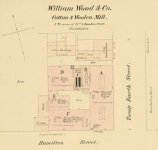NorILdigcollector
Sr. Member
I have some finds from the last few weeks that I have questions about. All three of these were found on a farm site that was active from 1835 to around 1900. The lead Disc I am completely unsure of. My best guess is a clock pendulum weight but I think lead is a strange material to use. It has a slot shaped into the back of it so I am guessing something slides into it. The middle flower button says "orange colour" on the back. Could this be Civil War? The other button says "Wm. Wood & Co. Phila. Extra Rich" on the back. Has anyone heard of this maker before? I can't seem to find any information on this maker.









